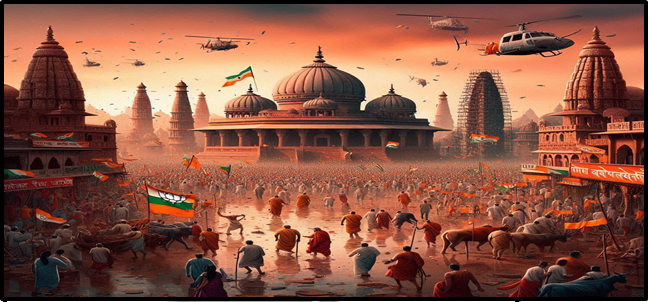THE IDEOLOGY OF SOCIAL PEACE IS STILL WORKING
Syllabus:
GS-1:
- Communalism, Secularism,Temple Architecture
GS-2:
- Government Policies and Interventions
Focus:
The BJP’s defeat in Ayodhya during the 2024 general election has sparked discussions on the ineffectiveness of using religious symbolism for electoral gains. This event has highlighted the Indian electorate’s rejection of divisive politics and the enduring legacy of social peace in India.
source:wikipedia
Political Reactions to Invitations:
- Controversial Remarks: Uttar Pradesh Minister Yogendra Upadhyay’s comment about Congress rejecting the Ram Mandir invitation, implying shallow mentality, sparked controversy.
- Comparison of Events: Comparing the invitation to the consecration ceremony of the Ram Mandir and Prime Minister Narendra Modi’s swearing-in highlights the political undertones.
- Doubts of Divine Origin: Such comparisons reflect a mentality similar to Modi’s past claims of divine origin, questioning his own biological birth.
- Political Strategy: The BJP’s invitation strategy is seen as a means to leverage religious events for political gain.
- Public Perception: These actions influence public perception, intertwining political and religious narratives.
Understanding Ayodhya and Ram Janmabhoomi:
About Ram Janmabhoomi Movement: Dispute to Construction of Ram Mandir:
Architecture of Ram Mandir: Nagara Style Grandeur and Design:
About Secularism in India:
About Constitutional provisions regarding secularism and freedom of religion:
|
Lord Ram and Electoral Politics:
- BJP’s Electoral Strategy: The BJP’s fixation on Lord Ram is believed to yield significant electoral benefits, influencing their political strategies.
- Empirical Evidence: Despite empirical evidence sometimes contradicting this belief, the BJP maintains its stance on the inviolable truth of Lord Ram’s influence.
- Historical Rise: The BJP’s rise from two Lok Sabha seats in 1984 to 303 in 2019 is often attributed to its association with Lord Ram.
- Advani’s Rath Yatra: L.K. Advani’s statement during the rath yatra emphasized political over religious aims, clearly indicating the political exploitation of Lord Ram.
- Election Timing: The timing of the Ram Mandir consecration close to the 2024 elections underscores the political motives behind religious events.
Failures and Lessons:
- 1992 Babri Masjid Demolition: The demolition of the Babri Masjid in 1992 did not yield the expected electoral victory for the BJP in subsequent state elections.
- 1993 State Elections: The BJP’s losses in Uttar Pradesh and other states in 1993 highlighted the failure of the Ram Lalla liberation wave to secure votes.
- First BJP Government: The formation of the first BJP government in 1998 was more due to coalition infighting than the Ram Mandir movement.
- Communal Agenda: Learning from these failures would have required the BJP to rethink its communal perspective, which remains central to the Sangh Parivar.
- 2014 Camouflage: In 2014, the BJP had to disguise its communal agenda with the broader slogan of development (vikas).
Ayodhya and the 2024 Election:
- BJP Defeat in Ayodhya: In the 2024 general election, the BJP’s defeat in Ayodhya by over 50,000 votes demonstrated the disconnect between electoral politics and the invocation of Lord Ram.
- Significant Loss: The loss of BJP veteran Lallu Singh to a Dalit rival, Awadhesh Prasad, was significant despite the BJP’s investment in the Ram temple.
- Repudiation of Hatred Politics: The election results reflected Indian voters’ rejection of divisive and hate-driven politics.
- Modi’s Indecorous Rhetoric: Prime Minister Modi’s electoral rhetoric was criticized for lacking the grace seen in past leaders like Nehru, Indira Gandhi, and Vajpayee.
- Learning Lessons: The question remains whether Modi, the BJP, or the RSS will learn from this rejection by the Indian electorate.
The Supreme Court and Historical Narratives:
- 2019 Supreme Court Judgment: The Supreme Court’s 2019 judgment on the Babri Masjid-Ram Janmabhoomi dispute upheld that no Ram temple was demolished under the masjid and that the demolition was a criminal act.
- Historians’ Views: The court’s decision aligned with the views of professional historians and archaeologists, countering the narrative of injustice for 500 years.
- Echoes of Injustice: Despite the judgment, some still propagate the idea of rectifying historical injustices.
- Selective Memory: The persistent narrative ignores historical and judicial clarifications, reflecting a selective memory in political discourse.
- Need for Historical Clarity: Recognizing and accepting historical and judicial perspectives is crucial for moving beyond divisive politics.
Continuing Legacy of Social Peace:
- Millennia-old Civilization: India’s ancient civilization has continuously asserted itself against the politics of hatred, showcasing resilience and unity.
- Medieval Legacy: The legacy of medieval saint-poets and the Bhakti movement promoted social harmony and religious tolerance.
- Universal God Concept: The Bhakti saints conceptualized a universal god, transcending religious rivalries and promoting social peace.
- Historical Communal Harmony: Despite political and denominational conflicts, genuine communal riots were rare, highlighting the effectiveness of social peace.
- Ideology of Social Peace: The enduring ideology of social peace continues to place constraints on divisive politics, emphasizing unity over division.
Conclusion:
The 2024 general election results indicate a clear repudiation of the politics of hatred and division. Despite efforts to leverage religious symbolism for political gains, the Indian electorate has chosen to prioritize unity and social harmony, reflecting the deep-rooted values of India’s ancient civilization.
source: The Hindu
Mains Practice Question:
Discuss the impact of religious symbolism on electoral politics in India, with reference to the 2024 general election results in Ayodhya. Analyze the broader implications for political strategy and social cohesion in the country.
Associated Article:
https://universalinstitutions.com/the-verdict-2024-general-elections/




